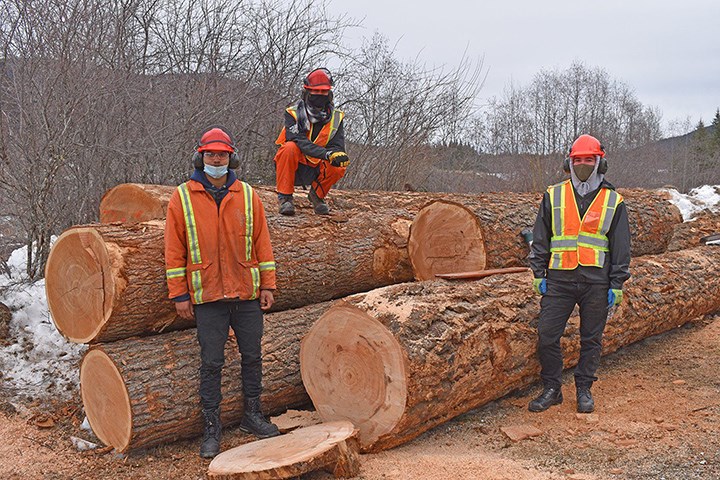The sky is the limit for Indigenous students, north of Williams Lake, where Brian Fuller is helping lead them through a 16-week program learning how to cut wood using a portable swing mill.
“I’ve been a part of something like this already with Toosey (Tl’esqox), so you kind of get an idea what you’re getting into, but it’s fun,” Fuller said at Xat’sull First Nation’s Whispering Willows Campsite.
In between walking the 10 participants — all from the Cariboo — through operating two different mills, Fuller also seized the opportunity to show them maintenance tips.
“You have to stay on them,” he said. “They’re just like a power saw, and if you abuse it, they fall apart.”
The goal of the community enhancement project is to build a new caretaker home designed by the participants who normally split their workdays between the campsite or doing classroom work at the former Soda Creek Emporium Restaurant.
Mornings always begin with Xat’sull First Nation (Soda Creek Indian Band) cultural co-ordinator Mike Retasket doing a drum song and smudging.
“It’s an exciting project because the long- term benefit not only for the participants but for the community is being able to build our own homes and employ and train our own people and have community members that can provide the milled wood that we need to do different things,” said Xat’sull economic development and employment co-ordinator Cheryl Chapman.
“In the long run, we’re anticipating that the sawmill will be a small business for the community.”
Chapman started working for Xat’sull when she was 16-years-old and said she would remark to her step-dad, a log home builder, if they had a sawmill, they could do it all when he said they should be building homes for their community.
Forestry and safety consultant Craig Kennedy started working with Chapman last August and had assisted her in putting forward a successful application for the program which is funded by the B.C. Government and Cariboo Chilcotin Aboriginal Training Employment Centre
He had helped oversee a similar program with Tl’esqox First Nation (Toosey) at Toosey Old School and Training Centre west of Williams Lake where four participants cut wood to build a dovetail home in 2017.
The home remains on-site for a 24-week carpentry training program delivered by the Nicola Valley Institute of Technology, which launched late-September 2020 for 20 Tsilhqot’in students.
“The whole premise was to see if we could build a house for $35,000 because that’s what the band got for new housing startups for Tl’esqox anyways,” Kennedy said, noting they were close but chose to drive up the price by adding some nice flooring, siding, and a wrap-around deck.
“The other reason we built it is so if we decide to make a business out of that, we have a show-home that people can come and look at down the road, which is the same thing we’re doing here.”
Chapman said Xat’sull receives less than $28,000 per housing startup—a number which hasn’t changed for several decades—from the federal government.
She believes milling her own lumber would have cut the costs in half to build her on-reserve home, which she had to borrow $116,000 to finish.
“I think the neatest opportunity that we came up with is teaching these young people that they can build their own house. We have a housing shortage in every Indigenous community in Canada,” Chapman said, adding how the challenges have come to light.
“There are two and three families living in one house, and if one person gets COVID the whole house is hooped.”
The home at Whispering Willows Campsite is anticipated to be completed in June and will provide accommodation for a full-time caretaker.
Xat’sull Chief Sheri Sellars said she is excited to see what will be next for participants and the community once the training program wraps up.
“It’s really endless,” Sellars said of the potential future opportunities.



